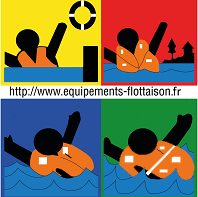MSC/Circ.1114 25 May 2004
GUIDELINES FOR PERIODIC TESTING OF IMMERSION SUIT AND ANTI-EXPOSURE SUIT SEAMS AND CLOSURES
1 The Maritime Safety Committee, at its seventy-eighth session (12 to 21 May 2004), recognizing that shipboard inspections of immersion suits and anti-exposure suits carried out in accordance with SOLAS regulation III/20.7 and MSC/Circ.1047 may not be adequate to detect deterioration of seams and closures of the suits due to adhesive ageing, and having considered the recommendation made by the Sub-Committee on Ship Design and Equipment at its forty-sixth session, approved the Guidelines for periodic testing of immersion suit and anti-exposure suit seams and closures, as set out in the annex.
2 Member Governments are invited to bring the annexed Guidelines to the attention of all parties concerned.
ANNEX
GUIDELINES FOR PERIODIC TESTING OF IMMERSION SUIT AND ANTI-EXPOSURE SUIT SEAMS AND CLOSURES
1 Research performed by several Member Governments has demonstrated that the seams and closures of immersion suits and anti-exposure suits experience deterioration over time. The rate and severity of deterioration may vary widely, depending upon the specific components and procedures employed in the manufacture of the suit and the conditions under which the suit is stored. However,
even under ideal conditions, the materials and adhesives used have a finite service life and will inevitably experience a reduction in strength and/or loss of watertightness with age.
2 The Guidelines for monthly shipboard inspection of immersion suits and anti-exposure suits (MSC/Circ.1047) are very helpful in identifying obvious problems with a suit, but do not adequately address deterioration of seams and closures (zippers, etc.) which may not be readily apparent by visual inspection. Such deterioration can be detected by pressurization of the suit with air, and testing of the seams and closures for leaks with a soapy water solution.
3 To ensure the maintenance of adequate strength and watertightness of seams and closures of immersion suits and anti-exposure suits with age, it is recommended that each suit be subjected to an air pressure test such as the following, at intervals not exceeding three years, or more frequently for suits over ten years of age:
.1 A suitable head piece, fitted with a means to inject air into the suit, should be inserted into the face orifice of the suit and secured so as to minimize leakage around the face seal. A low-pressure monitoring device, either integral to the fitting for air injection or as a separate device, should also be inserted. If the suit is fitted with detachable gloves and/or boots, the wrists and/or cuffs should be sealed by inserting a short length of suitable diameter plastic pipe and securing the gloves and/or boots with suitable wire ties or hose clamps. The zipper should be fully zipped, and any face flap closed. The suit should then be inflated to a pressure of 0.7 to 1.4 kPa (0.1 to 0.2 psi). If an auxiliary inflatable means of buoyancy is provided, it should be inflated through the oral valve to a pressure of 0.7 kPa (0.1 psi) or until firm to the touch.
.2 Each seam and closure of the suit – and each seam, oral tube and attachment points and joint or valve of any auxiliary inflatable means of buoyancy – should then be covered with a soapy water solution containing enough soap to produce bubbles (if leakage is noted at a foot valve to the extent that air pressure cannot be maintained, the valves should be sealed for the test).
.3 If leaks are revealed by the propagation of bubbles at seams or closures, the leaking areas should be marked and, after cleaning the suit thoroughly with fresh water and drying it, repaired in accordance with the suit manufacturer’s recommendations.
4 It is recommended that the air pressure test be performed at a suitable shore-based facility equipped to make any necessary repairs in accordance with the manufacturer’s recommendations. In view of the wide variety of materials and adhesives used in immersion suits and anti-exposure suits, it is strongly recommended that any repairs to a suit be carried out by a facility which has access to the original manufacturer’s recommended servicing instructions, parts and adhesives, and suitably trained personnel. The air pressure test may be carried out on board ship if suitable equipment is available.






